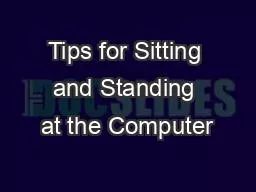

Using a fully height adjustable workstation allows for safe working postures in both sitting and standing positions These workstations promotepostural changes throughout the work day and havepositiv ID: 889605
Download Pdf The PPT/PDF document "Tips for Sitting and Standing at the Com..." is the property of its rightful owner. Permission is granted to download and print the materials on this web site for personal, non-commercial use only, and to display it on your personal computer provided you do not modify the materials and that you retain all copyright notices contained in the materials. By downloading content from our website, you accept the terms of this agreement.
1 Tips for Sitting and Standing at the Com
Tips for Sitting and Standing at the Computer Using a fully height adjustable workstation allows for safe working postures in both sitting and standing positions. These workstation s promote postural changes throughout the work day and have positive ergon omic and health benefits. This tip sheet provides basic set up and work flow practices to assist the computer user in safely using a sit - and - stand workstation. With any workstation set up, take movement breaks every hour and change your postures when you start to fatigue. Feet flat on the floor or footrest Majority of thighs supported Lower back well supported by chair Relax ed shoulders and arms Elbow close to side of the body Input devices at elbow height Eyes near top of the screen Stand when you start to feel restless Good foot support (low heeled supportive shoes or insoles and or a light weight cushioned mat ) Knees slightly bent (no locking) Shift weight, change leg position often Elbows close to the body Input devices at elbow level Eyes near top of the screen Sit down when you start to feel fatigue d Sitting Posture Standing Posture Your body is designed to move throughout the day. Standing or sitting in any one position for long periods has health disadvantages Listen to your body; change postures when you fatigue or star
2 t to slouch or slump forward St
t to slouch or slump forward Start by standing for short periods (5 - 10 minutes every hou r) Increase standing gradually based on your comfort le vel and individual limits. Current studies say to shoot for standing no more than 1/3 of your work day (about 20 minutes each hour) Understand that standing to work is not appropriate for all people . If you have any physical condition that may be aggravated by standing, (f oot, knee, hip arthritis or so me metabolic conditions ie: dia betes , etc.) discuss these recommendations with your health care provider and follow their recommendations UCSC Ergonomics @ Website: http://ehs.ucsc.edu/programs/ergo/ How to Set Up a User - Friendly Computer Workstation : http://ehs.ucsc.edu/programs/ergo/documents/computer - workstation - setup - steps.pdf Workstati on Furniture (Adjustable t ables, Chairs & Keyboard Trays ) : Contact Campus Ergonomist: Brian MacDonald at: bmacdon1@ucsc.edu Online Office C omput er Ergonomics T rainin g and S elf - A ssessment : https://login.ucsc.edu/idp/profile/SAML2/Redirect/SSO?execution=e1s1 Stretch Break Software: RSIGuard is our UCSC recommended break timing software and computer ergonomic optimization program. Av ailable for 45 day free trial. Single user l icense s available for purchase : h ttp://rsiguard .com/ To report an injury please contact your supervisor Resources for Computer Users Wor k Flow: The Next Posture is the Best Posture